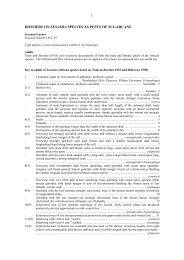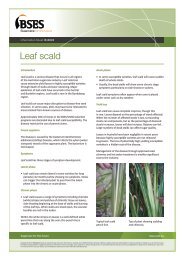Create successful ePaper yourself
Turn your PDF publications into a flip-book with our unique Google optimized e-Paper software.
14 Ramu<br />
BiOseCuriTy feATure / pArT 5 rAMu sTuNT<br />
1<br />
rAMu sTuNT<br />
iN This BuLLeTiN’s BiOseCuriTy feATure, Bses reseArChers BArry CrOfT,<br />
rOB MAGArey AND NADer sALLAM Offer Our reADers AN iNsiGhT<br />
iNTO rAMu sTuNT.<br />
stunt was first detected (and has<br />
only been found) in Papua New Guinea<br />
(PNG) where it is recognised as a major<br />
disease. In 1986, Ramu stunt almost<br />
destroyed the entire sugarcane industry<br />
at Gusap plantation in PNG. A 60%<br />
reduction in productivity was recorded<br />
in the highly susceptible cultivar ‘Ragnar’,<br />
which at that time occupied 90% of<br />
the plantation.<br />
Stools infected with Ramu stunt show<br />
severe stunting and eventually die.<br />
In infected plants the leaves become<br />
short, stiff and erect (Images 1–6). leaf<br />
symptoms vary with variety; some show<br />
stunting and chlorosis while in others leaf<br />
flecking is more predominant.<br />
4<br />
2 3<br />
biosecurity feature<br />
CAuse Of The DiseAse<br />
Recent work of <strong>BSES</strong> Indooroopilly based<br />
researcher Dr Kathy Braithwaite has led to<br />
a major breakthrough. She has identified<br />
a new virus in cane infected with Ramu<br />
stunt. Kathy’s research to characterise the<br />
virus is ongoing.<br />
spreAD Of The DiseAse<br />
A small plant hopper called Eumetopina<br />
flavipes spreads Ramu stunt. The disease<br />
can also spread through infected planting<br />
material. E. flavipes is 3–5 mm in length<br />
and has a distinctive black colour (Image 7).<br />
5 6<br />
Another planthopper common in<br />
Australian sugarcane fields (Perkinsiella<br />
saccharicida) is grey-brown in colour and<br />
does not transmit Ramu stunt.<br />
E. flavipes is widespread in the islands of<br />
the Indonesian Archipelago and is present<br />
on many of the Torres Strait islands; a<br />
small population also survives on the<br />
Australian mainland at Bamaga and New<br />
Mapoon on Cape York. However, the<br />
Australian populations do not harbour the<br />
disease, and this insect has never been<br />
found on Australian commercial crops.<br />
Growers who see this insect on their crops<br />
should contact their nearest <strong>BSES</strong> office<br />
immediately.




